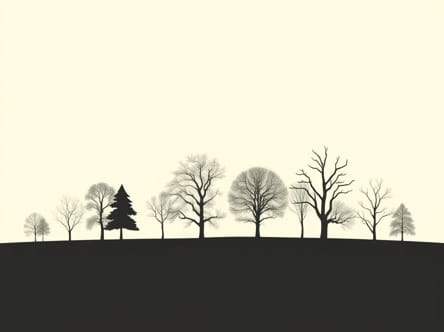Gardening in Zone 3 presents unique challenges due to its cold climate, with winter temperatures often dropping below -40°F (-40°C). Despite these harsh conditions, many deciduous trees can not only survive but thrive in this environment. Deciduous trees, known for shedding their leaves in the fall and returning to life each spring, bring seasonal beauty and structure to the landscape. Choosing the right trees for Zone 3 means looking for species that are hardy, adaptable, and resilient. This topic explores the best Zone 3 deciduous trees, planting tips, and maintenance strategies for long-term success.
Understanding USDA Hardiness Zone 3
Zone 3 is one of the coldest regions in the USDA Plant Hardiness Zone Map. It includes parts of the northern United States and much of Canada. Winters are long and severe, with short growing seasons. Trees in this zone must be able to withstand extreme cold, heavy snowfall, and late frosts in spring.
When selecting deciduous trees for Zone 3, consider the following:
- Cold hardiness rating
- Growth rate and mature size
- Soil and sunlight requirements
- Resistance to pests and diseases
Top Zone 3 Deciduous Trees for Home Gardens
1. Paper Birch (Betula papyrifera)
The paper birch is an iconic northern tree, instantly recognizable by its white peeling bark and delicate green leaves. It thrives in cold climates and offers excellent shade in summer and bright golden foliage in fall.
- Height: 50-70 feet
- Spread: 35-50 feet
- Soil: Moist, well-drained
- Sunlight: Full sun to partial shade
2. Amur Maple (Acer ginnala)
A great choice for smaller yards, the Amur maple is compact, easy to maintain, and known for its fiery red fall colors. It can also be pruned as a large shrub or a small tree.
- Height: 15-20 feet
- Spread: 15-25 feet
- Soil: Tolerates a wide range, well-drained
- Sunlight: Full sun to partial shade
3. American Mountain Ash (Sorbus americana)
This tree brings year-round interest with spring flowers, bright orange berries in summer, and brilliant fall foliage. The berries attract birds, making it a great addition to wildlife gardens.
- Height: 20-40 feet
- Spread: 15-25 feet
- Soil: Moist, acidic soil
- Sunlight: Full sun
4. Eastern Larch (Larix laricina)
Also called tamarack, the eastern larch is one of the few deciduous conifers. It grows fast, tolerates wet soils, and turns a beautiful golden-yellow before shedding its needles in the fall.
- Height: 40-80 feet
- Spread: 20-30 feet
- Soil: Moist to wet, acidic
- Sunlight: Full sun
5. Northern Red Oak (Quercus rubra)
This classic shade tree is both strong and beautiful. Known for its fast growth and deep red autumn color, the northern red oak is well-suited to large landscapes in Zone 3 regions.
- Height: 60-75 feet
- Spread: 45-50 feet
- Soil: Well-drained, slightly acidic
- Sunlight: Full sun
Additional Hardy Zone 3 Deciduous Trees
In addition to the popular species above, many other trees perform well in cold northern gardens. Here are a few more Zone 3-hardy deciduous trees to consider:
- Hackberry (Celtis occidentalis)– Durable and adaptable with corky bark and yellow fall color.
- Quaking Aspen (Populus tremuloides)– Known for its fluttering leaves and striking white bark.
- Kentucky Coffeetree (Gymnocladus dioicus)– Unique texture and large size, drought-tolerant once established.
- Serviceberry (Amelanchier spp.)– Small tree with edible berries and white spring blossoms.
Planting Tips for Deciduous Trees in Zone 3
Choose the Right Timing
Plant deciduous trees in early spring or late fall when the ground is not frozen. Spring planting allows roots to establish before the next winter sets in. Fall planting is possible, but make sure it’s at least six weeks before the first hard frost.
Prepare the Site
Dig a hole two to three times wider than the tree’s root ball but no deeper than the root ball itself. Amend the soil if it’s heavy clay or very sandy, and ensure good drainage to avoid root rot during freeze-thaw cycles.
Water Wisely
Newly planted trees require consistent moisture during the first growing season. Water deeply once or twice a week, depending on rainfall, but avoid overwatering. Mulching around the base helps conserve moisture and insulate the roots.
Provide Winter Protection
Young deciduous trees in Zone 3 can benefit from winter protection such as burlap wraps or tree guards to prevent sunscald and damage from rodents. A thick layer of mulch also helps regulate soil temperature.
Benefits of Planting Deciduous Trees in Zone 3
Despite the cold climate, growing deciduous trees in Zone 3 offers many rewards for homeowners and gardeners:
- Seasonal Interest– Trees offer spring blossoms, lush summer foliage, vibrant fall color, and winter silhouettes.
- Wildlife Habitat– Birds, insects, and small animals find food and shelter in and around deciduous trees.
- Environmental Value– Trees absorb carbon dioxide, reduce noise, improve air quality, and lower urban heat effects.
- Increased Property Value– Mature trees can enhance curb appeal and increase real estate value.
Gardening in cold regions like USDA Zone 3 doesn’t mean sacrificing beauty or variety. With the right choice of deciduous trees such as birch, maple, mountain ash, and oak you can create a thriving landscape that endures harsh winters and flourishes each growing season. Whether you’re designing a windbreak, shade canopy, or ornamental feature, these trees offer structure, function, and seasonal charm. Plan carefully, plant with care, and your Zone 3 deciduous trees will reward you for years to come.
